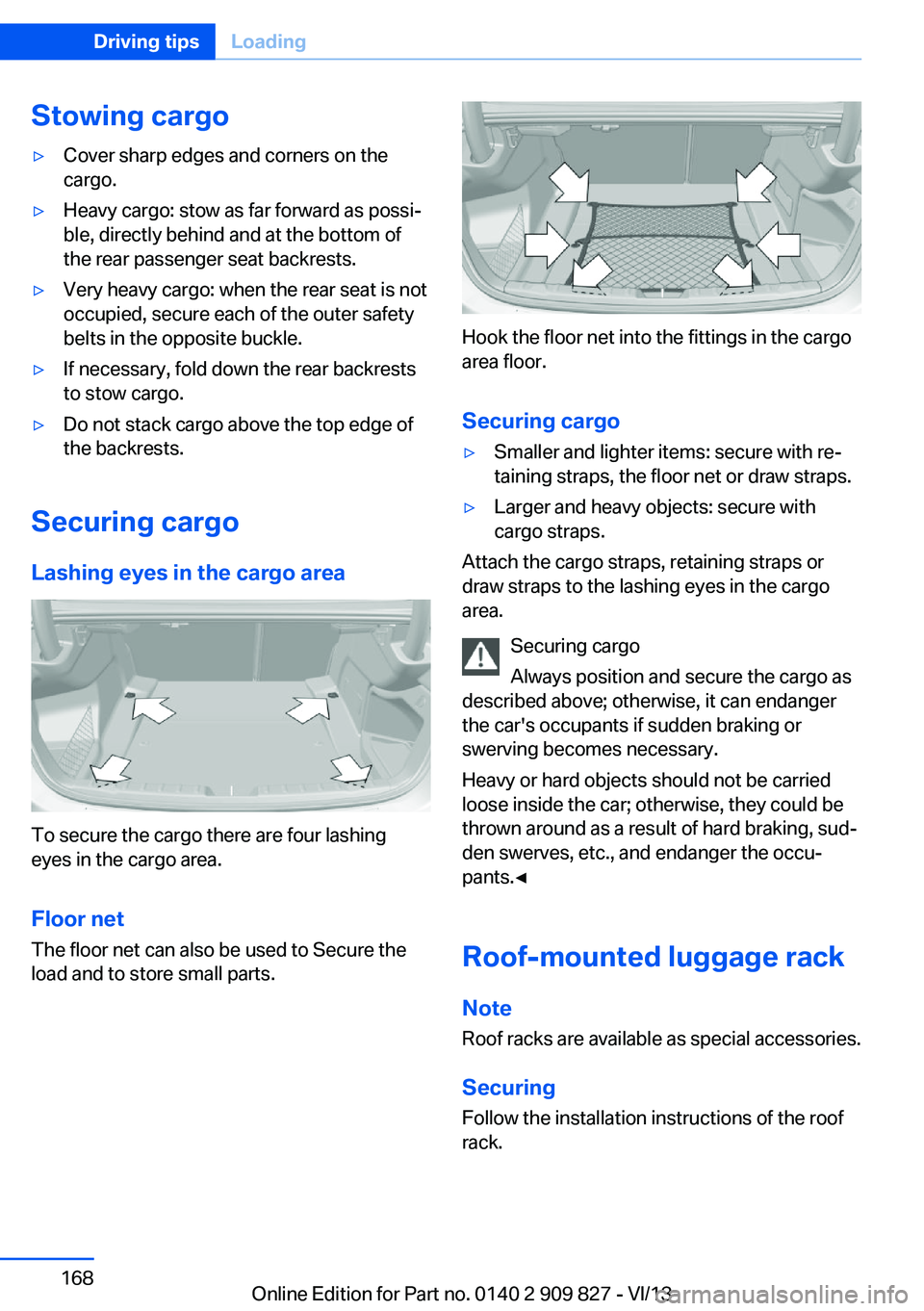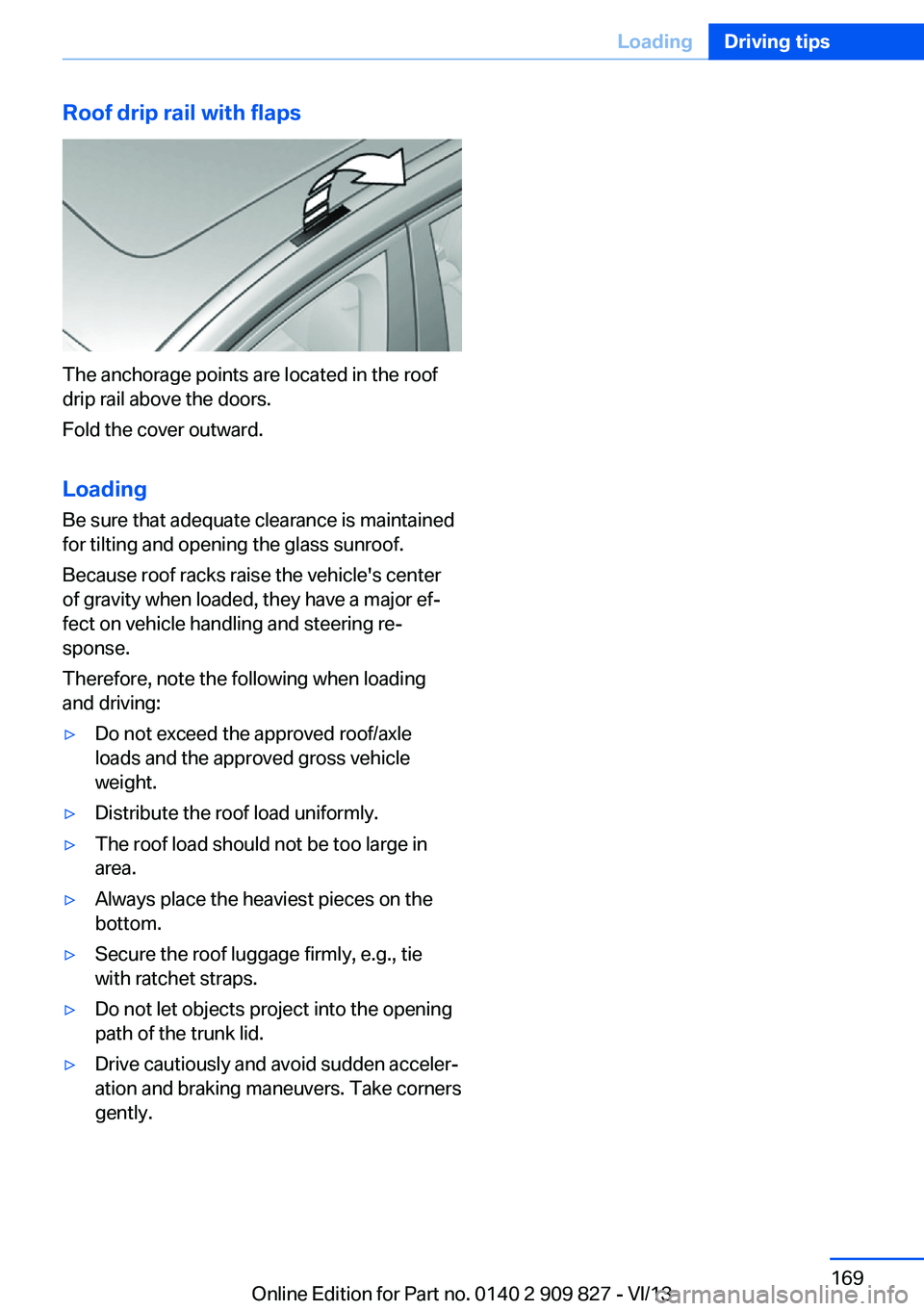2014 BMW 428I XDRIVE COUPE roof rack
[x] Cancel search: roof rackPage 168 of 236

Stowing cargo▷Cover sharp edges and corners on the
cargo.▷Heavy cargo: stow as far forward as possi‐
ble, directly behind and at the bottom of
the rear passenger seat backrests.▷Very heavy cargo: when the rear seat is not
occupied, secure each of the outer safety
belts in the opposite buckle.▷If necessary, fold down the rear backrests
to stow cargo.▷Do not stack cargo above the top edge of
the backrests.
Securing cargo
Lashing eyes in the cargo area
To secure the cargo there are four lashing
eyes in the cargo area.
Floor net
The floor net can also be used to Secure the
load and to store small parts.
Hook the floor net into the fittings in the cargo
area floor.
Securing cargo
▷Smaller and lighter items: secure with re‐
taining straps, the floor net or draw straps.▷Larger and heavy objects: secure with
cargo straps.
Attach the cargo straps, retaining straps or
draw straps to the lashing eyes in the cargo
area.
Securing cargo
Always position and secure the cargo as
described above; otherwise, it can endanger
the car's occupants if sudden braking or
swerving becomes necessary.
Heavy or hard objects should not be carried
loose inside the car; otherwise, they could be
thrown around as a result of hard braking, sud‐
den swerves, etc., and endanger the occu‐
pants.◀
Roof-mounted luggage rack
Note Roof racks are available as special accessories.
Securing
Follow the installation instructions of the roof
rack.
Seite 168Driving tipsLoading168
Online Edition for Part no. 0140 2 909 827 - VI/13
Page 169 of 236

Roof drip rail with flaps
The anchorage points are located in the roof
drip rail above the doors.
Fold the cover outward.
Loading Be sure that adequate clearance is maintained
for tilting and opening the glass sunroof.
Because roof racks raise the vehicle's center
of gravity when loaded, they have a major ef‐
fect on vehicle handling and steering re‐
sponse.
Therefore, note the following when loading
and driving:
▷Do not exceed the approved roof/axle
loads and the approved gross vehicle
weight.▷Distribute the roof load uniformly.▷The roof load should not be too large in
area.▷Always place the heaviest pieces on the
bottom.▷Secure the roof luggage firmly, e.g., tie
with ratchet straps.▷Do not let objects project into the opening
path of the trunk lid.▷Drive cautiously and avoid sudden acceler‐
ation and braking maneuvers. Take corners
gently.Seite 169LoadingDriving tips169
Online Edition for Part no. 0140 2 909 827 - VI/13
Page 170 of 236

Saving fuelVehicle equipmentAll standard, country-specific and optional
equipment that is offered in the model series is
described in this chapter. Therefore, equip‐
ment is also described that is not available in a
vehicle, e. g., because of the selected optional
equipment or country variant. This also applies
for safety-related functions and systems.
General information Your vehicle contains advanced technology for
the reduction of fuel consumption and emis‐
sions.
Fuel consumption depends on a number of dif‐
ferent factors.
The implementation of certain measures, driv‐
ing style and regular maintenance can have an
influence on fuel consumption and on the envi‐
ronmental impact.
Remove unnecessary cargoAdditional weight increases fuel consumption.
Remove attached parts
following use
Remove auxiliary mirrors, roof or rear luggage
racks which are no longer required following
use.
Attached parts on the vehicle impair the aero‐
dynamics and increase the fuel consumption.Close the windows and glass
sunroof
Driving with the glass sunroof and windows
open results in increased air resistance and
raises fuel consumption.
Tires General information
Tires can affect fuel consumption values in
various ways, for instance fuel consumption
can be influenced by the size of the tires.
Check the tire inflation pressure
regularly
Check and, if necessary, correct the tire infla‐
tion pressure at least twice a month and before
starting on a long trip.
Low tire inflation pressure increases rolling re‐
sistance and thus raises fuel consumption and
tire wear.
Drive away without delay Do not wait for the engine to warm-up while
the vehicle remains stationary. Start driving
right away, but at moderate engine speeds.
This is the fastest way for the cold engine to
reach its operating temperature.
Look well ahead when
driving
Avoid unnecessary acceleration and braking.
By maintaining a suitable distance to the vehi‐
cle driving ahead of you.
Driving smoothly and looking ahead reduces
fuel consumption.Seite 170Driving tipsSaving fuel170
Online Edition for Part no. 0140 2 909 827 - VI/13
Page 230 of 236

IIce warning, refer to External temperature warning 79
Icy roads, refer to External temperature warning 79
Identification marks, tires 184
Identification number, refer to Important features in the en‐
gine compartment 190
iDrive 16
Ignition key, refer to Remote control 32
Ignition off 61
Ignition on 61
Indication of a flat tire 98, 101
Indicator and warning lamps 76
Individual air distribu‐ tion 143, 146
Individual settings, refer to Personal Profile 33
Inflation pressure, tires 181
Inflation pressure warning FTM, tires 100
Info display, refer to Com‐ puter 84
Initialize, Tire Pressure Moni‐ tor TPM 98
Initializing, Flat Tire Monitor FTM 101
Instrument cluster 73
Instrument cluster, electronic displays 75
Instrument lighting 92
Integrated key 32
Integrated universal remote control 149
Intelligent Emergency Re‐ quest 210
Intelligent Safety 102
Intensity, AUTO pro‐ gram 145
Interior equipment 149
Interior lamps 92 Interior lamps via remote con‐
trol 36
Interior motion sensor 43
Interior rearview mirror 55
Interior rearview mirror, auto‐ matic dimming feature 55
Interior rearview mirror, com‐ pass 151
Internet page 6
Interval display, service re‐ quirements 80
J Jacking points for the vehicle jack 207
Joystick, automatic transmis‐ sion 70
Jump-starting 211
K Key/remote control 32
Keyless Go, refer to Comfort Access 39
Key Memory, refer to Per‐ sonal Profile 33
Kickdown, automatic trans‐ mission 70
Knee airbag 94
L
Lamp replacement 198
Lamp replacement, front 199
Lamp replacement, rear 204
Lamps 89
Lamps and bulbs 198
Lane departure warning 109
Lane margin, warning 109
Language on Control Dis‐ play 87
Lashing eyes, securing cargo 168
LATCH child restraint fixing system 58 Launch Control 71
Leather, care 217
LED light, bulb replace‐ ment 203
LEDs, light-emitting di‐ odes 199
Length, vehicle 223
Letters and numbers, enter‐ ing 22
Light alloy wheels, care 218
Light control 90
Light-emitting diodes, LEDs 199
Lighter 153
Lighting 89
Lighting via remote con‐ trol 36
Light switch 89
Load 167
Loading 167
Lock, door 37
Locking/unlocking from in‐ side 38
Locking/unlocking via door lock 37
Locking/unlocking with re‐ mote control 36
Locking, automatic 41
Locking, central 35
Locking, settings 41
Low beams 89
Low beams, automatic, refer to High-beam Assistant 91
Lower back support 49
Luggage rack, refer to Roof- mounted luggage rack 168
Lumbar support 49
M
Maintenance 196
Maintenance require‐ ments 196
Maintenance, service require‐ ments 80 Seite 230ReferenceEverything from A to Z230
Online Edition for Part no. 0140 2 909 827 - VI/13
Page 232 of 236

PDC Park Distance Con‐trol 128
Pedestrian warning with city braking function 107
Permissible axle load 223
Personal Profile 33
Pinch protection system, glass sunroof 45
Pinch protection system, win‐ dows 44
Plastic, care 218
Power failure 207
Power sunroof, glass 45
Power windows 43
Pressure, tire air pres‐ sure 181
Pressure warning FTM, tires 100
Profile, refer to Personal Pro‐ file 33
Programmable memory but‐ tons, iDrive 22
Protective function, glass sunroof 45
Protective function, win‐ dows 44
Push-and-turn switch, refer to Controller 16, 17
R Radiator fluid 195
Radio-operated key, refer to Remote control 32
Radio ready state 62
Radio, see user's manual for Navigation, Entertainment
and Communication
Rain sensor 67
Rear lamps 204
Rear socket 154
Rearview mirror 54
Rear window de‐ froster 143, 146
Recirculated-air filter 147 Recirculated-air
mode 143, 146
Recommended tire brands 187
Refueling 178
Remaining range 79
Remote control/key 32
Remote control, malfunc‐ tion 36
Remote control, univer‐ sal 149
Replacement fuse 208
Replacing parts 198
Replacing wheels/tires 187
Reporting safety defects 9
RES button 123
Reserve warning, refer to Range 79
Reset, Tire Pressure Monitor TPM 98
Retaining straps, securing cargo 168
Retreaded tires 187
Roadside parking lamps 90
Roller sunblinds 44
RON gasoline quality 180
Roof load capacity 223
Roof-mounted luggage rack 168
Rope for tow-starting/ towing 214
RSC Run Flat System Com‐ ponent, refer to Run-flat
tires 188
Rubber components, care 218
Run-flat tires 188
S Safe braking 165
Safety 7
Safety belt reminder for driv‐ er's seat and front passen‐
ger seat 51
Safety belts 51 Safety belts, care 218
Safety Package, refer to Ac‐ tive Protection 112
Safety systems, airbags 94
Saving fuel 170
Screen, refer to Control Dis‐ play 16
Screwdriver 198
Screw thread for tow fit‐ ting 215
Seat and mirror memory 53
Seat belts, refer to Safety belts 51
Seat heating, front 50
Seating position for chil‐ dren 57
Seats 47
Selection list in instrument cluster 84
Selector lever, automatic transmission 70
Sensors, care 219
Service and warranty 7
Service history 81
Service requirements, Condi‐ tion Based Service
CBS 196
Service requirements, dis‐ play 80
Service, Roadside Assis‐ tance 211
Services, ConnectedDrive
Settings, locking/unlock‐ ing 41
Settings on Control Dis‐ play 86
Settings, storing for seat, mir‐ ror 53
Shifting, automatic transmis‐ sion 69
Shifting, manual transmis‐ sion 69
Shift paddles on steering wheel 71
Side airbags 94
Side View 133 Seite 232ReferenceEverything from A to Z232
Online Edition for Part no. 0140 2 909 827 - VI/13